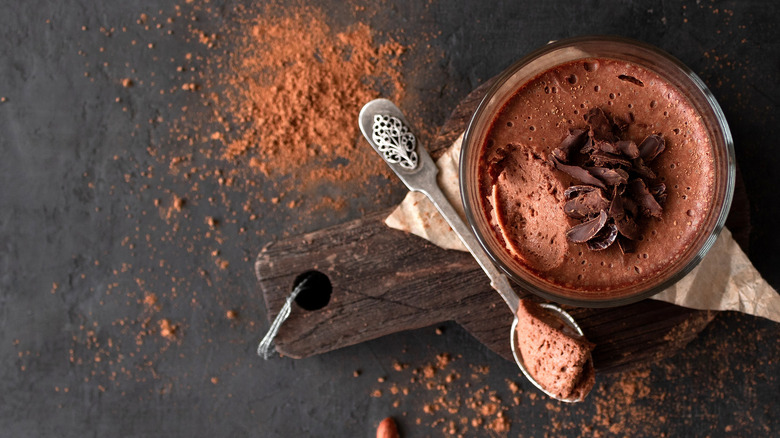Namelaka, The Chocolate Ganache Pastry Chefs Can't Get Enough Of
If you enjoy the taste of a luscious chocolate mousse, you'll love namelaka. Its name literally means "extremely creamy" in Japanese, and its delicate, whipped texture places it along the continuum of ganache and mousse. Plus, without the inclusion of eggs or flour, those with certain dietary restrictions can partake in this velvety creation.
To make namelaka, pastry chefs combine milk, gelatin powder, heavy whipping cream, and water with chocolate to create a glossy and versatile texture that is easy to work with. Though you'll need to plan in advance before tasting namelaka for yourself — the mixture is made in 10 minutes, but it takes half a day to set in the fridge — your patience will be well rewarded. Resting time allows time for the chocolate to crystallize and the gelatin to form a malleable, supple cream that can be used in an assortment of recipes. Because the liquid-to-chocolate ratio of namelaka is so high, chefs love having the ability to get creative with the taste and appearance of this smooth ingredient.
A versatile chocolate treat
Because the texture of set namelaka is so dreamlike, pastry chefs around the world are getting creative in using it to make unique and delicious desserts. Not only is creamy namelaka delicious to spoon into and eat on its own, but the shiny glean of the prepared treat also lends to cake decorations and fillings for baked goods. Once prepared, it can be tucked into pastries, lined along the edges of cakes, used to fill tarts, or layered into glasses for an elegant dessert presentation. The cream is soft enough to be worked through decorating bags and piped onto plates, yet the consistency will hold shape if spooned on top of a cut slice of flourless chocolate torte.
The well-known chocolate brand Valrhona is behind the invention of the treat, and quality chocolate like the brand's 70% bittersweet Guanaja dark baking chocolate made with cocoa beans from Trinidad, Dominican Republic, Ghana, and Madagascar, add a luxurious element to the end result. Flavor variations can be introduced to a standard namelaka recipe by infusing milk with other ingredients before putting the mixture together. Coffee, spices, extracts, and even splashes of citrus can provide a unique and flavorful type of namelaka that is difficult to resist.

